Tibialis Posterior Tendon Rupture
Updated:
(Also known as a Tibialis Posterior Rupture, Completely Torn Tibialis Posterior Tendon)
What is a tibialis posterior tendon rupture?
The tibialis posterior muscle originates from the back of the tibia and fibula, it then travels down along the inside of your lower leg and ankle where it inserts into various bones in the foot via the tibialis posterior tendon (figure 1). The tibialis posterior muscle is responsible for moving the foot and ankle towards the midline of the body (inversion – figure 2) and pointing the foot and ankle down (plantarflexion – figure 3). It also helps to maintain the normal arch of your foot.
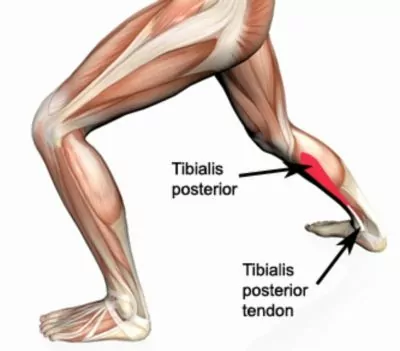
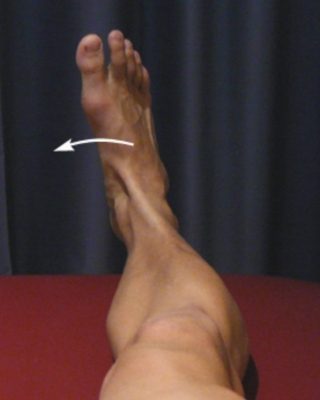
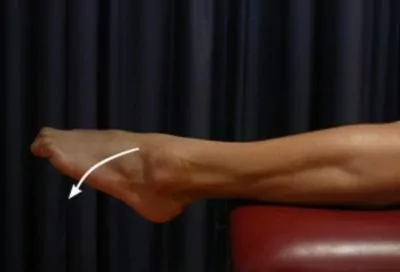
Whenever the tibialis posterior muscle contracts or is stretched, tension is placed through the tibialis posterior tendon. If this tension is excessive due to too much force or repetition, damage to the tibialis posterior tendon may occur. This can range from minor tearing of the tendon with subsequent inflammation to a complete tibialis posterior tendon rupture.
Signs and symptoms of tibialis posterior tendon rupture
Patients with a tibialis posterior tendon rupture may experience pain on the inside of their foot, ankle and lower leg. In addition, they may be unable to raise their heel in standing and may have a visibly flattened inner arch of the foot when compared to the normal side. There may also be visible swelling or thickening of the inner lower leg or ankle.
Diagnosis of tibialis posterior tendon rupture
A thorough subjective and objective examination from a physiotherapist may be all that is necessary to diagnose a tibialis posterior tendon rupture. Diagnosis may be confirmed with an MRI scan or ultrasound.
Treatment for tibialis posterior tendon rupture
All patients who potentially have a tibialis posterior tendon rupture should see a physiotherapist or doctor immediately so their condition can be assessed and the likelihood of them having a tibialis posterior tendon rupture determined. This is important as delayed treatment may result in a poor outcome. Meanwhile, initial injury management in the first 48 – 72 hours is vital to reduce bleeding, swelling and inflammation. This should comprise of rest from aggravating activity (crutches are often required), regular icing, the use of a compression bandage and elevation of the affected limb. Anti-inflammatory medication may also be useful in this early phase as guided by the treating doctor or pharmacist.
Immediate surgical reconstruction of the tibialis posterior tendon is indicated in patients who have a tibialis posterior tendon rupture. This is important to ensure optimal function of the foot and ankle. Following surgery, a period of immobilization in either a plaster cast or protective boot is likely. Rehabilitation of these injuries usually takes 6 months or longer with intensive physiotherapy.
Contributing factors to the development of tibialis posterior tendon rupture
There are several factors which can predispose patients to developing this condition . These need to be assessed and corrected with direction from your physiotherapist. Some of these factors include:
- poor flexibility
- inappropriate training
- poor biomechanics
- poor foot posture
- inadequate warm up
- muscle weakness
- inadequate rehabilitation following a previous injury
Physiotherapy for tibialis posterior tendon rupture
Physiotherapy treatment is vital to hasten the healing process, reduce the likelihood of recurrence and ensure an optimal outcome in all patients with this condition. Treatment may comprise:
- soft tissue massage
- electrotherapy (e.g. ultrasound)
- anti-inflammatory advice
- the use of crutches
- the use of heel wedges
- stretches
- joint mobilization
- ice or heat treatment
- exercises to improve strength, flexibility or balance
- education
- activity modification advice
- biomechanical correction
- a gradual return to activity program
Exercises for tibialis posterior tendon rupture
The following exercises are commonly prescribed to patients with this condition following surgical repair of the tibialis posterior tendon. You should discuss the suitability and timing of these exercises with your physiotherapist prior to beginning them. Generally, they should only be performed following surgery and when the treating physiotherapist has indicated it is safe and appropriate to perform them. They should be performed 1 – 3 times daily provided they do not cause or increase symptoms.
Foot and Ankle Up and Down
Move your foot and ankle up and down as far as possible and comfortable without pain (figure 4). Repeat 10 – 20 times provided there is no increase in symptoms.
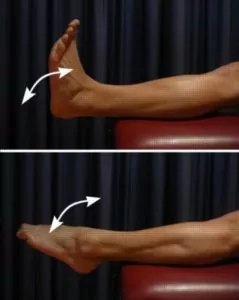
Foot and Ankle In and Out
Move your foot and ankle in and out as far as possible and comfortable without pain (figure 5). Repeat 10 – 20 times provided there is no increase in symptoms.
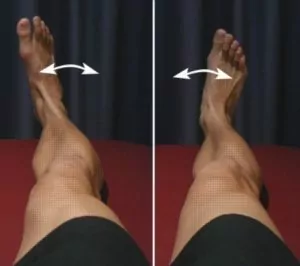
Ankle plantarflexion vs. resistance band
Begin this exercise with a resistance band around your foot as demonstrated and your foot and ankle held up towards your head (figure 6). Slowly move your foot and ankle down against the resistance band as far as possible and comfortable without pain. Repeat 10 – 20 times.

Lunge Stretch
Begin this exercise with your hands against the wall. Place the leg to be stretched in front of you as demonstrated. Keep your heel down. Gently move your knee forward over your toes until you feel a mild stretch in the back of your calf or Achilles region (figure 7). Hold for 15 seconds and repeat 4 times at a mild to moderate stretch provided there is no increase in symptoms.
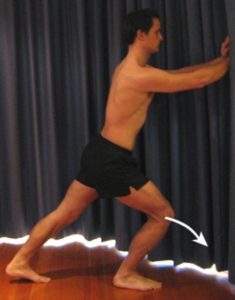
Find a Physio for tibialis posterior tendon rupture
Find a physiotherapist in your local area who can treat a ruptured tibialis posterior tendon.
Other Exercises
- View more calf flexibility exercises.
- View more calf strengthening exercises.
Physiotherapy products for tibialis posterior tendon rupture
Some of the most commonly recommended products by physiotherapists for patients with this condition include:
- Ice Packs or Heat Packs
- Heel Wedges
- Appropriate footwear or Orthotics
- Foam Rollers (for self massage)
- Crutches
To purchase physiotherapy products for a tibialis posterior tendon rupture click on one of the above links or visit the PhysioAdvisor Shop.

Link to this Page
If you would like to link to this article on your website, simply copy the code below and add it to your page:
<a href="https://physioadvisor.com.au/injuries/ankle/tibialis-posterior-tendon-rupture”>Tibialis Posterior Tendon Rupture – PhysioAdvisor.com</a><br/>PhysioAdvisor offers expert physiotherapy information on tibialis posterior tendon rupture including signs and symptoms, diagnosis, treatment, exercises, physiotherapy products and more...
Return to the top of Tibialis Posterior Tendon Rupture.
